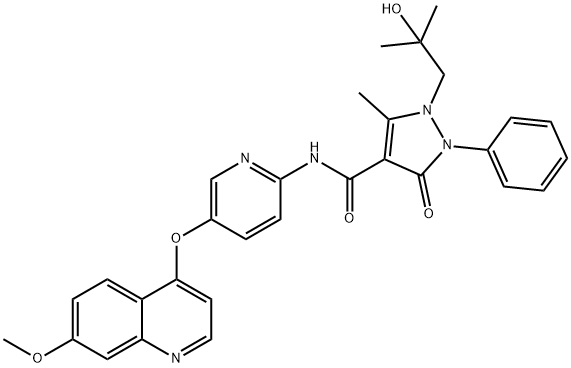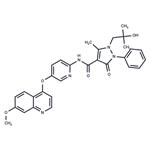
AMG 458
- Product NameAMG 458
- CAS913376-83-7
- CBNumberCB62500951
- MFC30H29N5O5
- MW539.58
- EINECS-0
- MDL NumberMFCD17169989
- MOL File913376-83-7.mol
- MSDS FileSDS
Chemical Properties
| Density | 1.339 |
| storage temp. | Store at -20°C |
| solubility | Soluble in DMSO |
| form | Powder |
| color | Off-white to pink |
| FDA UNII | 4535RW5Y3A |
AMG 458 Price
| Product number | Packaging | Price | Product description | Buy |
|---|---|---|---|---|
| TRC A614415 | 10mg | $415 | AMG-458 |
Buy |
| ApexBio Technology A8361 | 10mg | $478 | AMG-458 |
Buy |
| American Custom Chemicals Corporation KIN0000398 | 5MG | $505.77 | AMG-458 95.00% |
Buy |
| Biosynth Carbosynth FA64937 | 1mg | $120 | AMG 458 |
Buy |
| Biosynth Carbosynth FA64937 | 25mg | $700 | AMG 458 |
Buy |
AMG 458 Chemical Properties,Usage,Production
Uses
AMG-458 is a potent inhibitor of c-Met with an IC50 of 60 nM.Biological Activity
amg-458 is a potent and selective inhibitor of human and mouse c-met with ic50 value of 1.2 nm and 2.0 nm respectively.c-met, also known as hepatocyte growth factor receptor, is a receptor tyrosine kinase that can be activated by hepatocyte growth factor/scatter factor (hgf/sf). it is a membrane protein which plays an essential role in embryonic development and wound healing.recent study investigated the effect of amg-456 treatment on cell radiosensitizing response. the results showed that amg-458 treatment enhanced radiosensitivity in h441 with higher levels of c-met but not in a549 with lower expression of c-met [1].this component was also used in an animal model to study the role of c-met in the development of tumor. for instance, orally administration of amg-456 resulted in significant inhibition of tumor growth in /tpr-met and u-87 mg xenograft models without any adverse effect on body weight [2].Enzyme inhibitor
This potent c-Met protein kinase inhibitor (FW = 539.58 g/mol; CAS 913376-83-7; Solubility: 21 mg/mL DMSO; ~1 mg/mL H2O), also named 1-(2-hydroxy-2-methylpropyl)-N-(5-(7-methoxyquinolin-4-yloxy)pyridin- 2-yl)-5-methyl-3-oxo-2-phenyl-2,3-dihydro-1H-pyrazole-4-carboxamide, targets the MET proto-oncogene product c-Met, which is the hepatocyte growth factor receptor possessing tyrosine-kinase activity. The primary single-chain precursor protein is posttranslationally cleaved to produce the a and b subunits that are disulfide linked to form the mature receptor. Various mutations in the MET gene are associated with papillary renal carcinoma. AMG-458 preferentially inhibits c-Met (Ki = 1.2 nM), showing ~350-fold greater potency than VEGFR2 in cells. AMG-458 significantly inhibited tumor growth in the NIH3T3/TPR-Met and U-87 MG xenograft models with no adverse effect on body weight. AMG 458 binds covalently to liver microsomal proteins from rats and humans, even in the absence of NADPH. When [14C]AMG-458 is incubated with liver microsomes in the presence of glutathione or N-acetyl cysteine, quinolone-type thioether adducts can be detected by radiochromatographyand LC/MS/MS analysis. AMG-458 was more effective in cells that expressed higher levels of c-Met/p-Met, suggesting that higher levels of c- Met and p-Met in non-small cell lung cancer (NSCLC) tissue may classify a subset of tumors that are more sensitive to molecular therapies against this receptor.target
c-Met (H1094R)References
1. li b, torossian a, sun y, du r, dicker ap, lu b. higher levels of c-met expression and phosphorylation identify cell lines with increased sensitivity to amg-458, a novel selective c-met inhibitor with radiosensitizing effects. int j radiat oncol biol phys 2012,84:e525-531.2. liu l, siegmund a, xi n, kaplan-lefko p, rex k, chen a, et al. discovery of a potent, selective, and orally bioavailable c-met inhibitor: 1-(2-hydroxy-2-methylpropyl)-n-(5-(7-methoxyquinolin-4-yloxy)pyridin-2-yl)-5-meth yl-3-oxo-2-phenyl-2,3-dihydro-1h-pyrazole-4-carboxamide (amg 458). j med chem 2008,51:3688-3691.Preparation Products And Raw materials
AMG 458 Supplier
Global(75)Suppliers
| Supplier | Tel | Country | ProdList | Advantage | |
|---|---|---|---|---|---|
| +86-(0)57185586718 +86-13336195806 |
sales@capot.com | China | 29793 | 60 | |
| 86-13657291602 | linda@hubeijusheng.com | CHINA | 22963 | 58 | |
| +1-781-999-5354 +1-00000000000 |
marketing@targetmol.com | United States | 32161 | 58 | |
| +86-29-89586680 +86-15129568250 |
1026@dideu.com | China | 22787 | 58 | |
| +1-2135480471 +1-2135480471 |
sales@sarms4muscle.com | China | 10473 | 58 | |
| +1-708-310-1919 +1-13798911105 |
sales@invivochem.cn | United States | 6391 | 58 | |
| support@targetmol.com | United States | 38631 | 58 | ||
| +1-+1(833)-552-7181 | sales@aladdinsci.com | United States | 57505 | 58 | |
| 571-89925085 | sales@amadischem.com | China | 131957 | 58 | |
| +86-21-20908456 | sales@BioChemBest.com | China | 6005 | 61 |
View Lastest Price from AMG 458 manufacturers
AMG 458 Spectrum
913376-83-7, AMG 458Related Search
PROMPT×
PROMPT
The What'sApp is temporarily not supported in mainland China
The What'sApp is temporarily not supported in mainland China
Cancel
Determine
